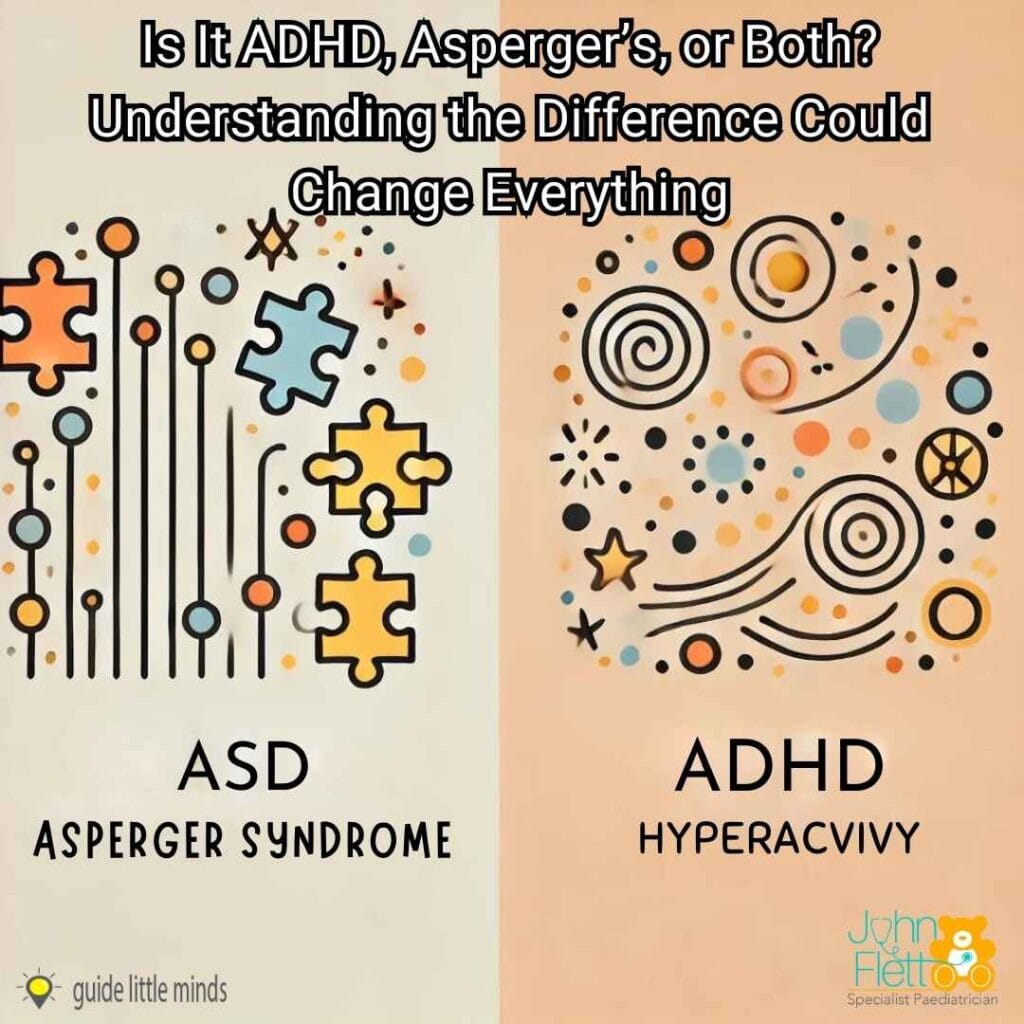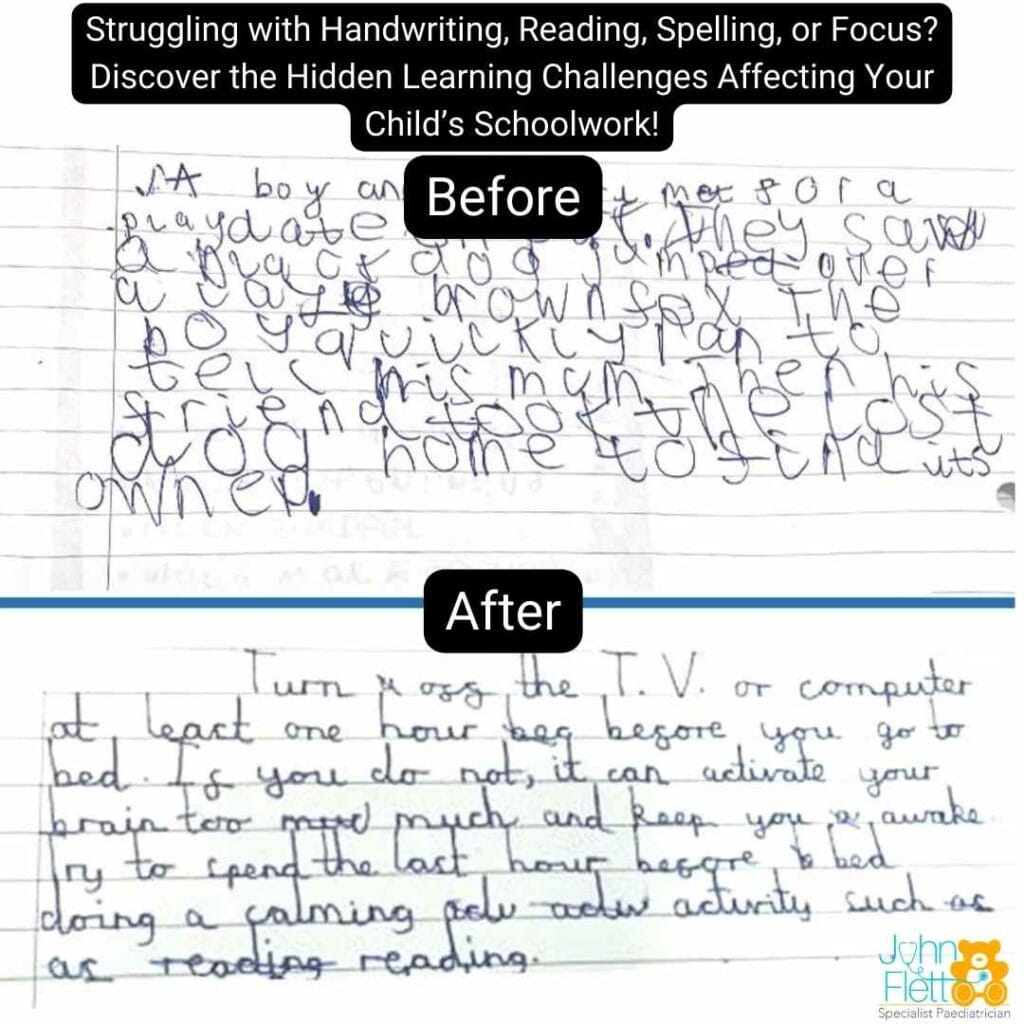Understanding Asperger Syndrome: Social Communication, Diagnosis, and the Overlap with ADHD

Key Differences at a Glance:
| Aspect | Asperger’s Syndrome | ADHD |
|---|---|---|
| Social Challenges | Difficulty understanding social rules and non-verbal cues | Difficulty maintaining attention, often appears distracted or interruptive |
| Emotional Regulation | Overwhelm due to sensory issues or misunderstanding social dynamics | Frustration and emotional outbursts from impulsivity and difficulty with self-control |
| Communication Style | Literal, difficulty with tone, facial expressions, sarcasm | Fluent but often disorganised, can be talkative and interruptive |
| Interests | Intense, focused on specific topics | Hyperfocus on fleeting interests, easily distracted |
| Body Language | Difficulty with eye contact, interpreting gestures | Can interpret non-verbal cues but often misses them due to inattention |
Asperger Syndrome, now classified as Autism Spectrum Disorder (ASD Level One) under the DSM-5, presents unique challenges in social communication, interaction, and behaviour. Individuals with Asperger’s often struggle with understanding the subtleties of social interaction, which can affect their relationships, emotional regulation, and daily functioning. However, it is essential to recognise that many individuals with Asperger’s still have the desire to socialise, but find the process confusing or overwhelming.
This article will explore the core features of Asperger Syndrome, how it differs from ADHD and social anxiety, and the most effective ways to diagnose this condition in children, adolescents, and adults.
1. The Core of Asperger Syndrome: Social Communication Challenges
At the heart of Asperger’s Syndrome is difficulty in understanding social communication. Neurotypical individuals typically pick up on the nuances of human interaction without explicit instruction. They learn through observation how to interpret body language, tone of voice, facial expressions, and the give-and-take of conversations. In contrast, individuals with Asperger’s often miss these unspoken rules and may struggle with:
- Social reciprocity: Knowing when to speak, how to respond, and how to maintain the natural rhythm of a conversation.
- Non-verbal communication: Difficulty reading or using facial expressions, gestures, or tone of voice.
- Interpreting emotions: Struggling to understand others’ emotions or expressing their own in a socially intuitive way.
This doesn’t mean they are uninterested in socialising; often, they do want to connect with others but find social interactions exhausting or confusing due to the lack of intuitive understanding.
2. Disinterest in Social Interaction vs Social Anxiety
It’s easy to mistake someone with Asperger’s for being disinterested in social interactions, but this isn’t always the case. Their social awkwardness often stems from not understanding how to engage, rather than not wanting to.
- Apparent Disinterest (Asperger’s): While some individuals with Asperger’s may seem content with less social interaction, this is often because socialising requires significant effort. They might prefer solitary activities due to sensory overload or because they find social rules difficult to navigate. However, many individuals with Asperger’s still want meaningful connections but struggle to maintain them.
- Social Anxiety: In contrast, people with social anxiety typically understand social norms but feel intense fear of being judged, embarrassed, or rejected. They avoid social situations due to a fear of negative evaluation rather than confusion about the interaction itself.
For instance, an adult with Asperger’s might miss social cues and struggle to maintain a conversation, feeling perplexed by others’ reactions. Someone with social anxiety, on the other hand, understands those cues but fears making a mistake in their execution.
3. Communication Differences in Asperger’s and Social Anxiety
People with Asperger’s often communicate in a literal and straightforward manner. They might miss the hidden meanings in jokes or metaphorical language, and small talk can seem pointless or confusing to them. This can make their communication appear factual or intense, particularly when discussing their specific interests.
In contrast, someone with social anxiety might have a firm grasp of non-verbal cues and conversational subtleties, but they may avoid participating in conversations due to fear of social judgment or failure. Their avoidance isn’t due to confusion but because of anxiety about how they will be perceived.
4. Asperger’s vs. ADHD: Understanding the Differences
Since both Asperger’s and ADHD can lead to social difficulties, it’s essential to differentiate between the two. While ADHD involves impulsivity and inattention, Asperger’s is more about difficulty understanding how social interaction works.
Core Differences:
- Asperger’s: Challenges arise from not intuitively understanding social rules. They may not grasp how to take turns in conversation or interpret others’ emotions. This often leads to social misunderstandings, despite their efforts to engage.
- ADHD: Social difficulties in ADHD are more related to inattention or impulsivity. Children with ADHD might interrupt conversations or struggle to follow because they’re distracted, but they typically understand social rules—they just find it hard to follow them consistently.
Emotional Regulation:
- Asperger’s: Emotional dysregulation often comes from sensory overload or difficulty interpreting social situations. Sensory sensitivities (like noise, bright lights, or crowded spaces) can lead to frustration or withdrawal.
- ADHD: Children with ADHD may have emotional outbursts or struggle with frustration because they have difficulty controlling their impulses. They may react impulsively without thinking through the consequences.
Repetitive Behaviours and Special Interests:
- Asperger’s: A key feature is the presence of restricted interests or repetitive behaviours. They might have deep, focused interests and struggle with changes in routine.
- ADHD: Intense interests may be fleeting, with the child hyper-focusing on something one moment and quickly moving on to something else. They are more flexible than individuals with Asperger’s in this regard.
Non-Verbal Communication:
- Asperger’s: Difficulty understanding or using non-verbal cues, such as facial expressions and gestures, is a hallmark. This can lead to monotone speech or unusual body language.
- ADHD: Non-verbal communication issues are generally less pronounced. If they miss cues, it’s more likely due to inattention than an inherent difficulty in understanding them.
5. When Asperger’s and ADHD Coexist
It’s also important to remember that ADHD and Asperger’s can coexist. Many children or adults with Asperger’s also have ADHD, which further complicates the picture. For example:
- Impulsivity combined with social misunderstandings: They might interrupt conversations due to ADHD while simultaneously struggling with social cues due to Asperger’s.
- Difficulty with transitions and routines: ADHD makes it hard to focus on tasks, while Asperger’s can lead to rigidity in routines.
- Emotional outbursts: Sensory overload from Asperger’s combined with impulsive frustration from ADHD can lead to emotional dysregulation.
Managing both conditions requires a tailored approach that addresses both the inattention and impulsivity of ADHD and the social communication challenges of Asperger’s.
6. Diagnosing Asperger Syndrome: The Process
Diagnosing Asperger Syndrome requires a comprehensive and structured process, particularly in adults or high-functioning individuals where symptoms may be subtle.
DSM-5 Criteria for ASD Level One:
The DSM-5 criteria for Autism Spectrum Disorder include:
- Persistent deficits in social communication and interaction.
- Restricted, repetitive patterns of behaviour, interests, or activities.
- Symptoms must be present from early childhood and cause significant impairment in social, occupational, or other areas of functioning.
The Role of Clinical Interviews and Rating Scales:
A thorough clinical interview is essential in gathering developmental history and current social challenges. Family input is crucial for younger individuals, and direct observation can help clinicians understand social and communication patterns.
The use of structured tools enhances diagnostic accuracy:
- ADOS-2 (Autism Diagnostic Observation Schedule): A semi-structured assessment that allows clinicians to observe communication and social interaction.
- SRS-2 (Social Responsiveness Scale): Assesses the severity of autism spectrum symptoms in social settings.
- AQ (Autism Spectrum Quotient): A self-administered questionnaire to measure autistic traits in adolescents and adults.
- ADI-R (Autism Diagnostic Interview-Revised): A structured interview with caregivers, focusing on early childhood symptoms.
7. Conclusion: Navigating the Complexities of Asperger’s and ADHD
The core difference between Asperger’s and ADHD lies in the nature of the social difficulties. While individuals with Asperger’s struggle with understanding the nuances of social interaction, those with ADHD generally understand these rules but have trouble following them due to impulsivity or inattention.
However, the complexity increases when both conditions coexist, requiring careful management to address both sets of challenges. Early and accurate diagnosis is crucial, as it allows for tailored interventions that can help individuals thrive socially, academically, and emotionally.
Whether through a thorough clinical interview or using standardised rating scales like ADOS-2, ensuring a proper diagnosis opens the door to meaningful support and improved outcomes for individuals with Asperger Syndrome or ADHD.
By understanding the distinctions and overlaps between Asperger’s and ADHD, we can ensure that individuals receive the right support, helping them navigate the social world more effectively and live fulfilling lives.
4o






Responses